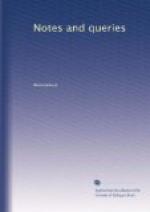Philatus (what objection is there to Latinising, in the usual way, the Greek termination os?) is, of course, intended for Hobbes; and, to convey Eachard’s opinion of him, his opponent in the Dialogue is Timothy, a God-honourer.
Let me add, as you have headed Mr. Wyatt’s communication “Tracts attributed to Eachard,” thereby casting a doubt upon his authorship, that there is no doubt about Dr. John Eachard being the author of all the tracts which Mr. Wyatt enumerates; nor was there any concealment by Eachard. His authorship of the Grounds and Occasions of the Contempt of the Clergy is notorious. The “Epistle Dedicatory,” signed “J.E.,” mentioned by Mr. Wyatt as prefixed to the Dialogue on Hobbes’ State of Nature, refers also to the five subsequent letters. These were published at the same time with the Dialogue on Hobbes, in one volume, and are answers to attacks on the Grounds and Occasions, &c. The Epistle Dedicatory is addressed to Gilbert Sheldon, Archbishop of Canterbury, “and,” says Eachard, “I hope my dialogue will not find the less acceptance with your Grace for these Letters which follow after.”
The second edition of the volume I have by me, published in 1672: the title, Mr. Hobbes’s State of Nature considered, &c.; to which are added, Five Letters from the Author of “The Grounds and Occasions of the Contempt of the Clergy."
C.
Masters of St. Cross.—In reply to “H. EDWARDS” (No. 22. p. 352.), A List of the Masters of St. Cross, I believe, is given in Browne Willis’s Mitred Abbies, vol. i.; but the most correct and perfect list is in the Sketches of Hampshire, by the late John Duthy, Esq. Henry or Humfrey de Milers is the first master whose name is recorded, and nothing further is known of him: between Bishop Sherborne and Bishop Compton there were thirteen masters.
F.J.B.
Has “H. EDWARDS” seen the History of St. Cross Hospital, by Mr. Moody, published within the last six months? It may materially assist him.
JOHN R. FOX
A living Dog better than a dead Lion.—Your correspondent “MR. JOHN SANSOM” may, perhaps, accept the following as an answer to the first part of his Query (No. 22. p. 352.). In an ancient MS. preserved in the archives of the see of Ossory, at fol. 66., is entered, in a hand of the latter part of the fourteenth century, a list of ancient proverbs under the following heading:— {405}
“Eux sount les proverbes
en fraunceys conferme par auctorite del
Dibil?
“Chers amys
receiuez de moy
Un beau present
q vo’ envoy,
Non pas dor ne
dargent
Mais de bon enseignment,
Que en escriptur
ai trove
E de latin translatee,
&c. &c.”
Amongst them is the following:—




